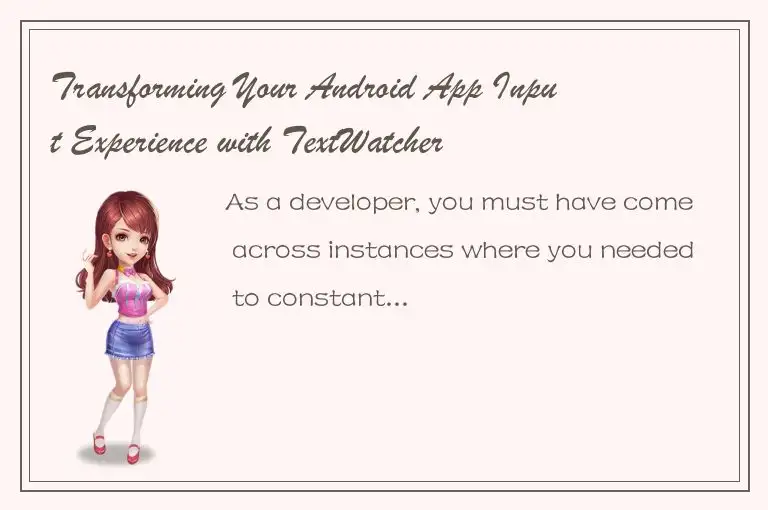As a developer, you must have come across instances where you needed to constantly monitor the text entered by the user in an EditText setup, well, Android provides an elegant solution to that known as TextWatcher. You can think of it as a listener that monitors every keystroke of the user on an EditText and informs you right away so you can have your app react appropriately. This article will be looking at TextWatcher and how it can enhance your app's input experience.

TextWatcher in Android
TextWatcher can be defined as an interface that you can use to monitor changes made to the text of an Editable object. EditText extends TextView, and an Editable object can be thought of as a sequence of characters that allow modification. When you attach a TextWatcher to an EditText via its addTextChangedListener() method, the TextWatcher will be notified of every change the user makes to the text via three methods: beforeTextChanged(), onTextChanged(), and afterTextChanged().
beforeTextChanged() is invoked just before the text is changed. The method gets the text's current state, the starting position of the text to be replaced, the number of characters being replaced, and the number of characters being added.
onTextChanged() is invoked while you type text or delete text. The method gets the text's current state, the starting position of the text to be replaced, the number of characters being replaced, and the number of characters being added.
afterTextChanged() is invoked just after the text has been changed. The method gets the text's final state.
TextWatcher implementation in Android
To make use of TextWatcher, you need to implement the TextWatcher interface in your code. Here is a sample implementation:
```
editText.addTextChangedListener(new TextWatcher() {
@Override
public void beforeTextChanged(CharSequence s, int start, int count, int after) {
//This method is called to notify you before text has changed
}
@Override
public void onTextChanged(CharSequence s, int start, int before, int count) {
//This method is called to notify you when text has changed
}
@Override
public void afterTextChanged(Editable s) {
//This method is called to notify you after text has changed
}
});
```
As stated earlier, the three methods of the TextWatcher interface give you different states of the text, and you can act on them as you see fit. For example, you can use the afterTextChanged() method to validate the user's input and give feedback.
Improved Input Experience with TextWatcher
Custom validation in real-time
By using TextWatcher to validate user input, you can provide real-time validation feedback to your users. For instance, if you have an app that accepts email addresses, you can use the onTextChanged() method to validate the text input every time the user types a new character. If the input does not match the format of an email address, you can highlight the input with a red border, and if it matches, you can show a green border. This way, your user will know if they have entered a valid email address before submitting the form.
Search Feature
Using TextWatcher in the search feature of your app can improve the user experience. Normally, you will have a search bar where the user can input their search query. By using TextWatcher, you can set up your app to start searching even before the user clicks the search button. In other words, the app will actively search for results as the user is still typing in their query. This way, the user doesn't have to type their whole query before hitting the search button before they know if their search query was valid or not.
Formatting input
Sometimes, you want your app to format user input automatically. For instance, if you have an app that requires phone numbers, you can use TextWatcher to format the user's input into a more readable format. With this, users don't need to remember to format their input as they type, and it improves data consistency.
Limiting input length
Another use of TextWatcher is to limit the length of text input by users. In scenarios where you want to limit the number of characters the user can input, you can use TextWatcher to monitor the number of characters entered in EditText, and stop the user from exceeding the specified limit. This way, you control the quality of data that is entered and improve validation, and the user experience.
Conclusion
TextWatcher provides an efficient means to listen and react to text input changes in Android apps. It provides a range of applications for developers from real-time validation feedback to improved search functionality and formatting input. This article has highlighted some of the ways you can use TextWatcher to improve the input experience in your app. Adding TextWatcher can enhance your app's functionality and enhance the user experience, leading to greater user satisfaction.




 QQ客服专员
QQ客服专员 电话客服专员
电话客服专员